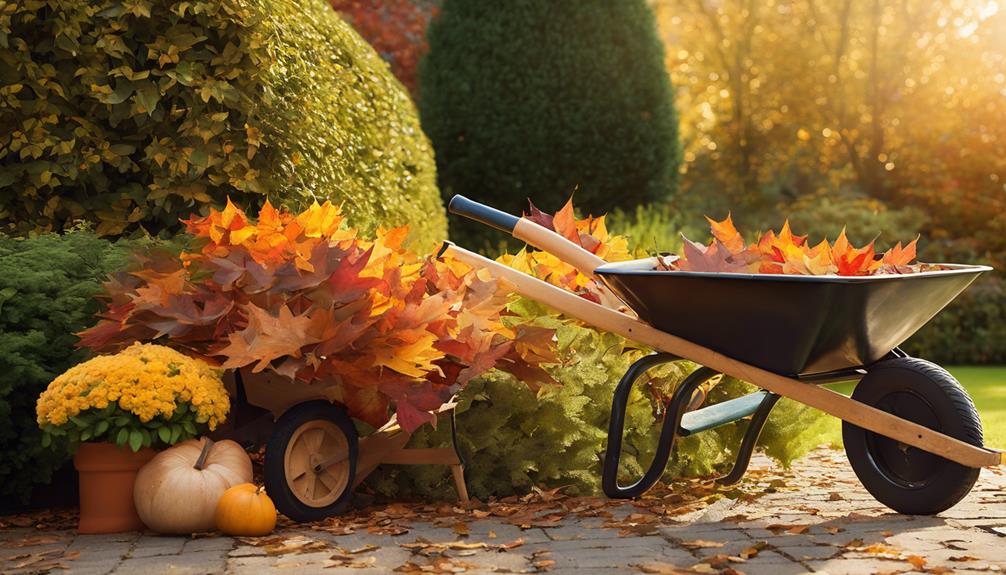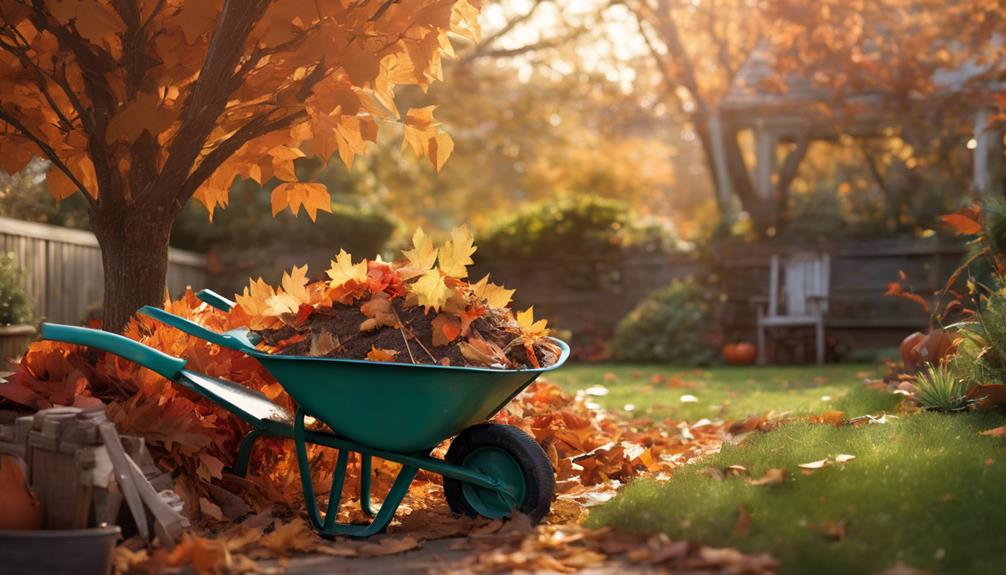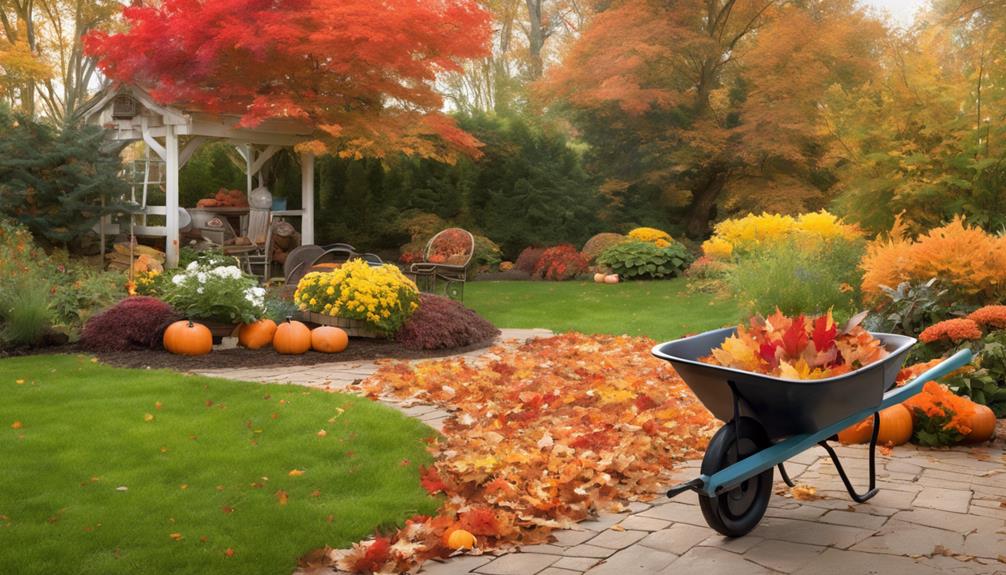
What Are the Top Seasonal Garden Cleanup Services?
11 October 2024
Budget-Friendly Tips for Fall Garden Cleanup
11 October 2024Top seasonal garden cleanup services in your area are essential for maintaining a healthy and vibrant outdoor space.
These professionals specialise in fundamental tasks such as soil quality assessment, pruning, and pest control strategies. They employ effective methods to enhance plant growth while managing weeds and preparing your garden for the changing weather conditions.
By utilising organic techniques and innovative tools, they ensure your garden thrives season after season. Choosing a reputable service can transform your landscape into a flourishing environment.
Discover more about specific services and how they can enhance your garden's health and aesthetics.
Seasonal Garden Maintenance Essentials
Effective seasonal garden maintenance hinges on two critical practices: pruning and trimming techniques, along with soil preparation strategies.
Proper pruning encourages healthy growth and enhances the aesthetic appeal of plants, while diligent soil preparation ensures optimal nutrient availability and drainage.
Together, these elements form the foundation for a thriving garden throughout the changing seasons.
Pruning and Trimming Techniques
Proper pruning and trimming techniques are essential for maintaining a healthy and aesthetically pleasing garden. Mastering these skills improves plant health, encourages vigorous growth, and promotes flowering.
Begin by understanding the specific needs of each plant species, as timing and methods vary widely. Employ clean, sharp tools to make precise cuts, minimising damage and promoting swift healing.
Focus on the three P's: removing dead, diseased, or damaged wood; improving air circulation; and shaping for visual appeal. Techniques such as thinning, heading back, and rejuvenation pruning each serve unique purposes.
Regularly assess your plants throughout the growing season, as proper timing can greatly impact flowering and fruiting. Ultimately, informed pruning cultivates a vibrant and resilient landscape that thrives year after year.
Soil Preparation Strategies
How can one ensure that the garden flourishes from the very start of the growing season? Effective soil preparation is crucial.
Begin by conducting a thorough soil test to assess pH levels and nutrient deficiencies, allowing for precise amendments. Incorporate organic matter, such as compost, to enhance soil structure and fertility, fostering beneficial microbial activity.
Cultivation should be comprehensive; tilling to a depth of at least 30 centimetres promotes aeration and root development. Moreover, consider crop rotation and cover cropping to improve soil health and mitigate pest issues.
Ultimately, implement proper drainage techniques to prevent waterlogging, which can hinder plant growth. By adhering to these strategies, gardeners can cultivate a solid foundation for a thriving garden ecosystem.
Soil Quality and Preparation
Soil quality is crucial to a thriving garden, necessitating careful preparation and management.
Incorporating organic matter enhances nutrient availability, while mulching serves to retain moisture and regulate temperature.
Furthermore, implementing seasonal pest control strategies is vital to protect the soil ecosystem and support healthy plant growth.
Organic Matter Incorporation
Incorporating organic matter into garden soil is fundamental for improving soil quality and preparing it for optimal plant growth. Organic matter, such as compost, well-rotted manure, leaf mould, and green manure, enriches the soil, improves its structure, and increases nutrient availability.
This process not only fosters healthy root development but also boosts microbial activity, which is crucial for nutrient cycling.
Key benefits of incorporating organic matter include:
- Improved soil structure: Enhances aeration and drainage.
- Increased moisture retention: Aids soil in retaining water, thereby reducing irrigation needs.
- Enhanced nutrient content: Provides essential nutrients for plants.
- Promotes biodiversity: Encourages beneficial microorganisms and earthworms.
Mulching for Moisture Retention
Utilising mulch effectively improves moisture retention in garden beds, a crucial factor for sustaining plant health during dry periods.
By applying a well-chosen layer of mulch, gardeners can considerably enhance soil quality, reduce evaporation, and promote a stable environment for root systems.
Consider these key benefits of mulching:
- Moisture Conservation: Reduces water loss, keeping soil consistently hydrated.
- Temperature Regulation: Insulates the soil, preventing extreme temperature fluctuations.
- Weed Suppression: Minimises weed growth, allowing plants to access more moisture and nutrients.
- Soil Structure Improvement: As organic mulches break down, they enrich the soil with essential nutrients.
Incorporating these practices into your seasonal garden cleanup can lead to a thriving, resilient garden ecosystem.
Seasonal Pest Control Strategies
Implementing effective seasonal pest control strategies begins with a thorough assessment of soil quality and preparation.
Healthy soil not only supports robust plant growth but also enhances natural pest resistance. Here are critical considerations for optimising your soil:
- Test Soil pH: Ensure the pH is suitable for your plants, as imbalanced pH can attract pests.
- Incorporate Organic Matter: Adding compost improves soil structure and increases beneficial microorganisms that deter pests.
- Aerate the Soil: Proper aeration enhances drainage and prevents conditions conducive to pest infestations.
- Crop Rotation: Regularly changing plant types can disrupt pest life cycles and reduce their populations.
Garden Tool Preparation Tips
Proper garden tool preparation is essential for an effective seasonal clean-up. This includes gathering essential gardening tools, ensuring they are clean and well-maintained, and performing necessary pruning to promote healthier plant growth.
Gather Essential Gardening Tools
A well-equipped gardener understands that having the right tools at hand is crucial for an effective seasonal cleanup.
To ensure a smooth and efficient process, consider gathering the following essential gardening tools:
- Pruning Shears: For trimming dead branches and promoting healthy growth.
- Rake: To clear leaves and debris, preparing your garden beds for planting.
- Trowel: Ideal for digging, planting, and transplanting small plants.
- Garden Fork: Useful for aerating soil and mixing in compost or fertilisers.
Having these tools at the ready not only boosts productivity but also enhances your gardening experience.
Mastery in seasonal cleanup begins with the appropriate equipment, allowing you to tackle the challenges of your garden with confidence and precision.
Tool Cleaning and Maintenance
Before embarking on your seasonal garden tidy-up, it is essential to clean and maintain your tools to ensure they perform at their best.
Neglecting tool maintenance can lead to inefficiencies and hinder your gardening efforts.
Follow these fundamental tips for optimal tool care:
- Clean after each use: Remove soil and debris to prevent rust and damage.
- Sharpen blades: Ensure cutting tools are sharp for clean cuts, which reduce plant stress.
- Oil metal parts: Applying a light coat of oil prevents corrosion and ensures smooth operation.
- Store properly: Keep tools in a dry, organised space to avoid exposure to moisture and prolong their lifespan.
Pruning for Healthier Growth
Pruning is a vital practice for promoting healthier growth in plants, enabling them to thrive and flourish throughout the growing season. Proper pruning techniques not only enhance plant aesthetics but also improve air circulation and light penetration, fostering robust development.
To prepare your tools for effective pruning, consider the following tips:
- Sharpen Blades: Ensure your pruning shears and saws are sharp to create clean cuts that minimise stress on plants.
- Sanitise Tools: Disinfect tools with rubbing alcohol to prevent the transfer of diseases between plants.
- Inspect for Damage: Check tools for wear and tear, replacing any damaged parts to maintain efficiency.
- Practice Proper Technique: Familiarise yourself with specific pruning techniques for different plant species to achieve the best results.
Enhanced Plant Growth Potential
Maximising plant growth potential is a crucial aspect of seasonal garden clearance services. Effective clearance not only removes debris but also improves soil health and optimises planting conditions. By systematically addressing factors such as nutrient availability, moisture retention, and pest control, garden professionals cultivate an environment conducive to robust growth.
| Factor | Importance | Clearance Strategy |
|---|---|---|
| Soil Health | Supports root development | Aeration and amendment |
| Nutrient Availability | Boosts photosynthesis | Fertilisation and composting |
| Moisture Retention | Reduces irrigation needs | Mulching and proper drainage |
Implementing these strategies during seasonal clearance can significantly enhance the growth potential of plants, ensuring a vibrant and thriving garden throughout the growing season.
Seasonal Weed Management Techniques
Effective seasonal weed management is crucial for maintaining a healthy garden.
Utilising pre-emergent herbicides can prevent weed seeds from germinating, whilst post-emergent treatments target existing weeds.
Furthermore, spot treatments offer a focused approach for managing particularly stubborn weed populations, ensuring the comprehensive health of your landscape.
Pre-Emergent Herbicide Application
As the gardening season approaches, implementing pre-emergent herbicide application becomes a critical strategy in seasonal weed management.
This proactive technique helps prevent the germination of annual weeds, ensuring a healthier garden environment. By applying pre-emergent herbicides at the right time, typically in early spring, you can significantly reduce weed competition for nutrients and water.
Key benefits of pre-emergent herbicide application include:
- Weed Prevention: Stops weeds before they establish themselves.
- Efficient Resource Utilisation: Enhances the availability of nutrients for desired plants.
- Reduced Labour: Minimises the need for frequent weeding sessions.
- Enhanced Aesthetics: Promotes a cleaner, more attractive garden appearance.
Mastering this technique will set a solid foundation for a thriving garden throughout the season.
Post-Emergent Herbicide Treatment
While pre-emergent herbicides play a significant role in preventing weed growth before it begins, post-emergent herbicide treatment is equally important for managing existing weeds that have already emerged.
This technique targets actively growing weeds, ensuring that they do not compete with your desired plants for nutrients, water, and sunlight.
Key considerations for effective post-emergent herbicide application include:
- Timing: Apply during optimal weather conditions and when weeds are actively growing.
- Type of Herbicide: Choose selective herbicides to protect desired plants while eliminating weeds.
- Application Method: Use appropriate equipment for even distribution and penetration.
- Follow-Up Care: Monitor treated areas for resurgent weeds and reapply as necessary.
Implementing these strategies will enhance your garden's health and appearance.
Spot Treatment for Stubborn Weeds
Many gardeners encounter stubborn weeds that resist traditional removal methods, making spot treatment an essential technique for seasonal weed management.
This targeted approach minimises harm to desirable plants while effectively addressing invasive species.
To master spot treatment, consider the following techniques:
- Selective Herbicides: Use herbicides formulated for specific weed types to reduce collateral damage.
- Manual Removal: Hand-pulling or digging can be effective for isolated infestations, especially with deep-rooted species.
- Boiling Water: Pouring boiling water directly onto the weeds can effectively kill them without harsh chemicals.
- Mulching: Apply mulch around plants to suppress weed growth and retain soil moisture.
Implementing these strategies will improve your garden's health and maintain its aesthetic appeal throughout the season.
Weather-Related Plant Damage
Weather-related plant damage can pose significant challenges for gardeners, particularly in regions susceptible to frost.
Implementing effective frost protection strategies, such as the use of frost cloths, can safeguard tender plants during unexpected cold snaps.
Furthermore, selecting frost-resistant plant varieties can enhance resilience and minimise potential losses in the garden.
Frost Protection for Tender Plants
Frost protection for tender plants is fundamental for safeguarding their health during the colder months. As temperatures drop, the risk of frost damage increases, jeopardising the robustness of sensitive species.
Implementing effective protective measures is necessary for maintaining an ideal growing environment. Consider the following strategies:
- Mulching: Apply a layer of organic mulch to insulate roots and retain soil warmth.
- Plant Placement: Position tender plants in sheltered areas, such as near walls or under trees, to reduce exposure.
- Watering: Watering plants before a frost can help them retain heat, protecting them from cold snaps.
- Monitoring Temperatures: Stay informed about local weather forecasts to anticipate frost events and act pre-emptively.
These strategies will improve the resilience of your tender plants against frost-related threats.
Frost Cloth for Plant Protection
The use of frost cloths is a crucial tactic for gardeners seeking to protect their delicate plants from potentially damaging cold temperatures.
These lightweight yet effective materials provide an important barrier against frost, ensuring the survival of sensitive flora during harsh weather conditions.
Key benefits of utilising frost cloths include:
- Temperature Regulation: Maintains a warmer microclimate around plants.
- Moisture Control: Prevents excessive moisture loss while allowing air circulation.
- UV Protection: Shields plants from harmful ultraviolet rays without restricting light.
- Versatility: Suitable for a variety of plant types and can be easily adjusted for different sizes.
Frost-Resistant Plant Selection
Selecting frost-resistant plants is essential for gardeners aiming to minimise the risk of weather-related damage during colder months.
By choosing the right varieties, you can enhance the resilience of your garden landscape. Focus on plants known for their ability to withstand lower temperatures and frost conditions.
Consider incorporating the following frost-resistant selections into your garden:
- Pansies: Hardy and colourful, they thrive in cold weather.
- Hellebores: Known for their early blooms, they endure frost exceptionally well.
- Sedum: This succulent tolerates cold while providing texture.
- Ornamental Cabbage: Adds visual interest and withstands frigid temperatures.
With these selections, you can create a robust garden that endures the chill while providing beauty and continuity.
Why Choose TKL Birmingham Gardener
Choosing a reliable gardening service can significantly enhance the health and aesthetics of your outdoor space. TKL Birmingham Gardener stands out for its commitment to excellence and a thorough understanding of horticultural practices.
Their team of skilled professionals employs tailored strategies to ensure your garden thrives throughout the seasons. Utilising eco-friendly techniques, they prioritise sustainability while enhancing the beauty and functionality of your landscape.
TKL Birmingham Gardener also offers personalised consultations, allowing clients to express their vision and receive expert advice. With a reputation built on reliability and customer satisfaction, their services guarantee meticulous attention to detail.
Common Gardening Questions Answered
Addressing common gardening questions is vital for both novice and experienced gardeners seeking to improve their outdoor spaces. One frequent inquiry pertains to soil health; understanding the importance of soil composition and pH levels is fundamental for optimal plant growth.
Moreover, many gardeners ask about the best practices for watering; a deep, infrequent watering schedule generally promotes stronger root systems. Pest management is another common concern; employing integrated pest management strategies can effectively reduce damage while preserving beneficial insects.
Additionally, gardeners often seek guidance on seasonal planting schedules to enhance yields. By answering these questions, we empower individuals to cultivate thriving gardens, enhancing both aesthetic appeal and ecological balance in their surroundings.
Mastery in gardening stems from continuous learning and adaptation to these foundational principles.
Final Cleanup Recommendations
As the gardening season draws to a close, implementing final cleanup recommendations is essential for maintaining a healthy and vibrant garden for the following year.
This process not only prepares your garden for winter but also enhances soil health and reduces pest problems.
- Remove all dead plant material to prevent the spread of disease.
- Trim back perennials and cut back annuals to encourage new growth.
- Compost healthy plant debris while disposing of diseased materials appropriately.
- Apply a layer of mulch to protect the soil and regulate temperature.




